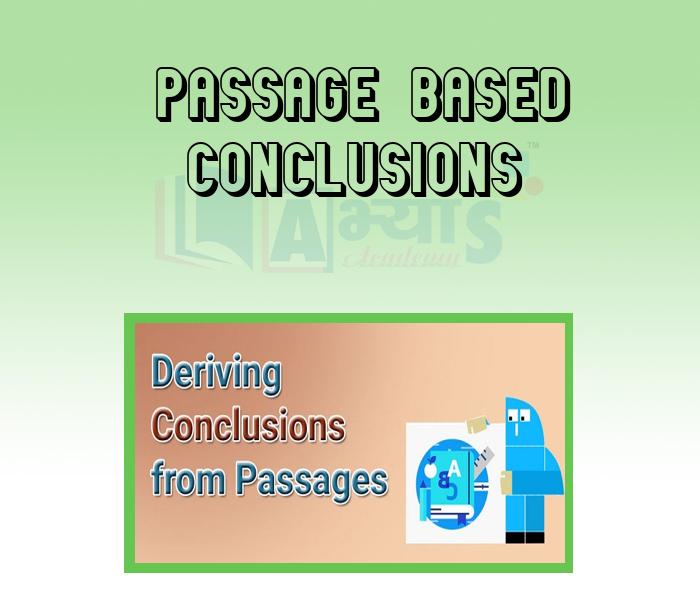Passage Based Conclusions

Passage Based Conclusions
Passage Based Conclusions : This is basically drawing inferences from the passage. An inference is the act or process of deriving logical conclusion from premises known or assumed to be true. These passages are based on social, economic, political and technological conditions.
Every student must note that it is very important for them to possess logical skills, comprehension capacity and ability for interpretation. They must be skillful enough to comprehend the full implications of the passage and arrive at the correct answer. It is expected of the students to acquire as much knowledge as possible of phrasal verbs, vocabulary and nature of the English language. In these types of questions, a passage is given on any topic followed by conclusions in the form of statements. A candidate is required to mark out the answer in the following ways
Give answer
The candidate must note that all these conclusions are to be arrived at in the light of what has been discussed in the passage. In the following passages the methodology will be discussed as to how to opt for right option : (a, b, c, d) which a candidate is expected to select for a given conclusion.
These type of questions are used to detect the candidate's ability to decide the situation or draw an inference based on a situation described to him. This topic is an integral part of reasoning.
Example :
Passage : The performance of Indian agriculture is largely dependent on amount of rainfall across the country. A substantive part of the cultivable land is dependent on irrigation which directly related to monsoon. However, agriculture and allied activities account for less on even one-fourth of the total GDP. The component of the manufacturing sector that depends on agriculture for the supply of intermediates is not very high, which suggests that he structure of industrialization has changed over the years. Several components of the tertiary sector that are crucial for the growth of the rest of the economy have grown sizeably, thanks to IT and BPO. So it is less likely that aggregate economic growth will be adversely affected if rainfall is scanty. Yet, a somewhat different picture emerges if we look deeper into the matter. Still, a very significant chunk of the population and work force depends on agriculture for its livelihood. A decline in agriculture reduces per capita food availability, which in turn, pulls down the standard of living.
Question 1 : Manufacturing sector no longer depends on agricultural sector.
Answer : (e) : It is mentioned in the passage that the component of the manufacturing sector that depends on agriculture for the supply of intermediates is not very high. This implies that a part of the manufacturing sector still depends on agriculture. Hence, the given inference is definitely false.
Question 2 : Weak monsoon have adverse effect on GDP even though non-agricultural sector activities may continue to be the same.
Answer : (d) : The sentence 'So it is less likely... if rainfall is scanty' in the passage implies that it is quite probable that a weak monsoon may not have an adverse effect on GDP. Hence, the given inference is probably false.
Passage : The performance of Indian agriculture is largely dependent on amount of rainfall across the country. A substantive part of the cultivable land is dependent on irrigation which directly related to monsoon. However, agriculture and allied activities account for less on even one-fourth of the total GDP. The component of the manufacturing sector that depends on agriculture for the supply of intermediates is not very high, which suggests that he structure of industrialization has changed over the years. Several components of the tertiary sector that are crucial for the growth of the rest of the economy have grown sizeably, thanks to IT and BPO. So it is less likely that aggregate economic growth will be adversely affected if rainfall is scanty. Yet, a somewhat different picture emerges if we look deeper into the matter. Still, a very significant chunk of the population and work force depends on agriculture for its livelihood. A decline in agriculture reduces per capita food availability, which in turn, pulls down the standard of living. Question : Agro-based activities constitute more than 25 percent of GDP in India. | |||
| Right Option : D | |||
| View Explanation | |||
Directions : Read the following passage and examine the inference given below it in the context of this passage. The performance of Indian agriculture is largely dependent on amount of rainfall across the country. A substantive part of the cultivable land is dependent on irrigation which is directly related to monsoon. However, agriculture and allied activities account for less than even one - fourth of the total GDP. The component of the manufacturing sector that depends on agriculture for the supply of intermediates is not very high, which suggests that the structure of industrialization has changes over the years.Several components of the tertiary sector that are crucial for the growth of the rest of the economy have grown sizeably, thanks to IT and BPO. So it is less likely that aggregate economic growth will be adversely affected if rainfall is scanty. Yet, a somewhat different picture emerges if we look deeper into the matter. Still, a very significant chunk of the population and work force depends on agriculture for its livelihood. A decline in agriculture reduces per capital food availability, which in turn, pulls down the standard of living. Agro - based activities constitute more than 25 percent of GDP in India. | |||
| Right Option : D | |||
| View Explanation | |||
Directions : Read the following passage and examine the inference given below it in the context of this passage. The world Health organization has called for an improved surveillance to combat dengue and says the outbreak can be controlled in two weeks if all necessary steps are taken to stop the mosquitoes from breeding and break the transmission cycle. Dengue is already the most widespread mosquito - borne disease among humans. In the past 15 years, outbreaks in South and South - East Asia have been rapidly rising mostly due to falling environmental and public health standards during urbanization. WHO reports that severe forms of the disease such as haemorrhagic fever (DHF) and shock syndrome (DSS) are putting more than 2.5 million people at risk worldwide each year. Importantly, 95% of the DHF cases are among children less than 15 years. therefore, the disease has major impact on public health and future generations. There was no outbreak of dengue in the European countries in the recent past. | |||
| Right Option : C | |||
| View Explanation | |||
Students / Parents Reviews [20]
One of the best institutes to develope a child interest in studies.Provides SST and English knowledge also unlike other institutes. Teachers are co operative and friendly online tests andPPT develope practical knowledge also.

Aman Kumar Shrivastava
10thI have spent a wonderful time in Abhyas academy. It has made my reasoning more apt, English more stronger and Maths an interesting subject for me. It has given me a habbit of self studying

Yatharthi Sharma
10thWhen I have not joined Abhyas Academy, my skills of solving maths problems were not clear. But, after joining it, my skills have been developed and my concepts of science and SST are very well. I also came to know about other subjects such as vedic maths and reasoning.

Sharandeep Singh
7thMy experience with Abhyas is very good. I have learnt many things here like vedic maths and reasoning also. Teachers here first take our doubts and then there are assignments to verify our weak points.

Shivam Rana
7thAbhyas is a complete education Institute. Here extreme care is taken by teacher with the help of regular exam. Extra classes also conducted by the institute, if the student is weak.

Om Umang
10thWe started with lot of hope that Abhyas will help in better understnding of complex topics of highers classes. we are not disappointed with the progress our child has made after attending Abhyas. Though need to mention that we expected a lot more. On a scale of 1-10, we would give may be 7.

Manya
8thAbhyas academy is great place to learn. I have learnt a lot here they have finished my fear of not answering.It has created a habit of self studying in me.The teachers here are very supportive and helpful. Earlier my maths and science was good but now it has been much better than before.

Barkha Arora
10thAbout Abhyas metholodology the teachers are very nice and hardworking toward students.The Centre Head Mrs Anu Sethi is also a brilliant teacher.Abhyas has taught me how to overcome problems and has always taken my doubts and suppoeted me.

Shreya Shrivastava
8thAbhyas Methodology is very good. It is based on according to student and each child manages accordingly to its properly. Methodology has improved the abilities of students to shine them in future.

Manish Kumar
10thAbhyas is an institute of high repute. Yogansh has taken admission last year. It creates abilities in child to prepare for competitive exams. Students are motivated by living prizes on basis of performance in Abhyas exams. He is satisfied with institute.

Yogansh Nyasi
7thIt has a great methodology. Students here can get analysis to their test quickly.We can learn easily through PPTs and the testing methods are good. We know that where we have to practice

Barkha Arora
10thIt was a good experience with Abhyas Academy. I even faced problems in starting but slowly and steadily overcomed. Especially reasoning classes helped me a lot.

Cheshta
10thThird consective year,my ward is in Abhyas with nice experience of admin and transport support.Educational standard of the institute recumbent at satisfactory level. One thing would live to bring in notice that last year study books was distributed after half of the session was over,though study ...

Ayan Ghosh
8thBeing a parent, I saw my daughter improvement in her studies by seeing a good result in all day to day compititive exam TMO, NSO, IEO etc and as well as studies. I have got a fruitful result from my daughter.

Prisha Gupta
8thIt was good as the experience because as we had come here we had been improved in a such envirnment created here.Extra is taught which is beneficial for future.

Eshan Arora
8thAbhyas institute is one of the best coaching institute in the vicinity of Ambala cantt.The institute provides good and quality education to the students.The teachers are well experienced and are very helpful in solving the problems. The major advantages of the institute is extra classes for weak...

Shreya Shrivastava
8thA marvelous experience with Abhyas. I am glad to share that my ward has achieved more than enough at the Ambala ABHYAS centre. Years have passed on and more and more he has gained. May the centre flourish and develop day by day by the grace of God.

Archit Segal
7thThe experience was nice. I studied here for three years and saw a tremendous change in myself. I started liking subjects like English and SST which earlier I ran from. Extra knowledge gave me confidence to overcome competitive exams. One of the best institutes for secondary education.

Aman Kumar Shrivastava
10thMy experience was very good with Abhyas academy. I am studying here from 6th class and I am satisfied by its results in my life. I improved a lot here ahead of school syllabus.

Ayan Ghosh
8thMy experience with Abhyas academy is very good. I did not think that my every subject coming here will be so strong. The main thing is that the online tests had made me learn here more things.







